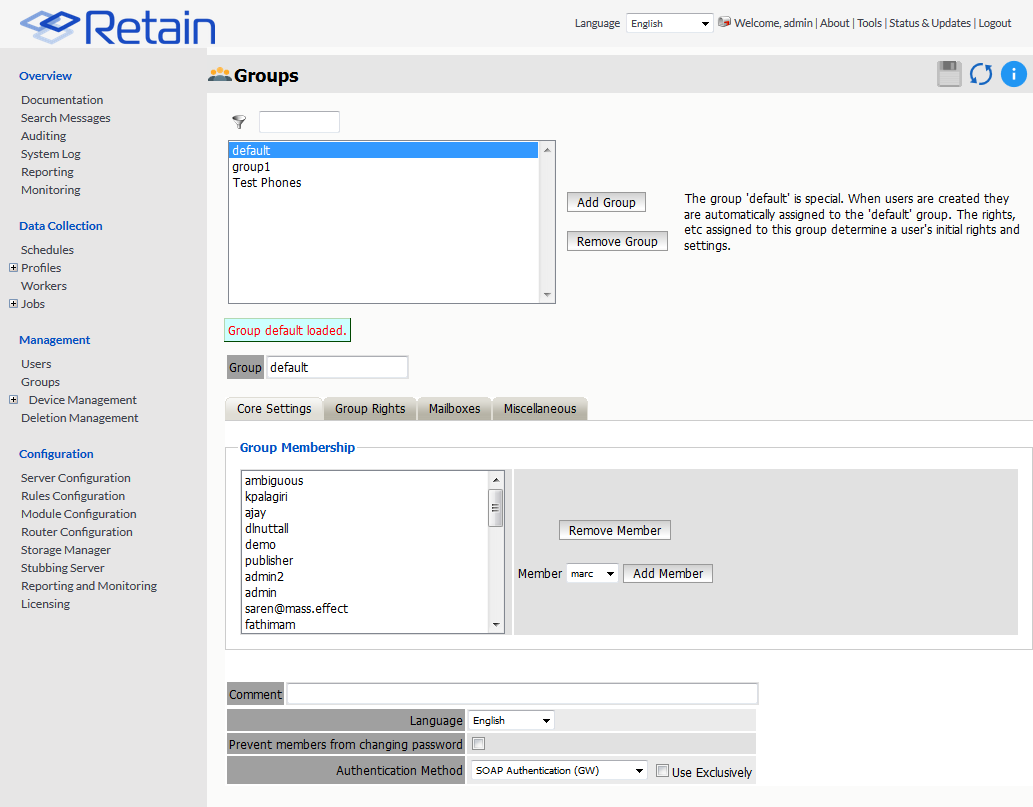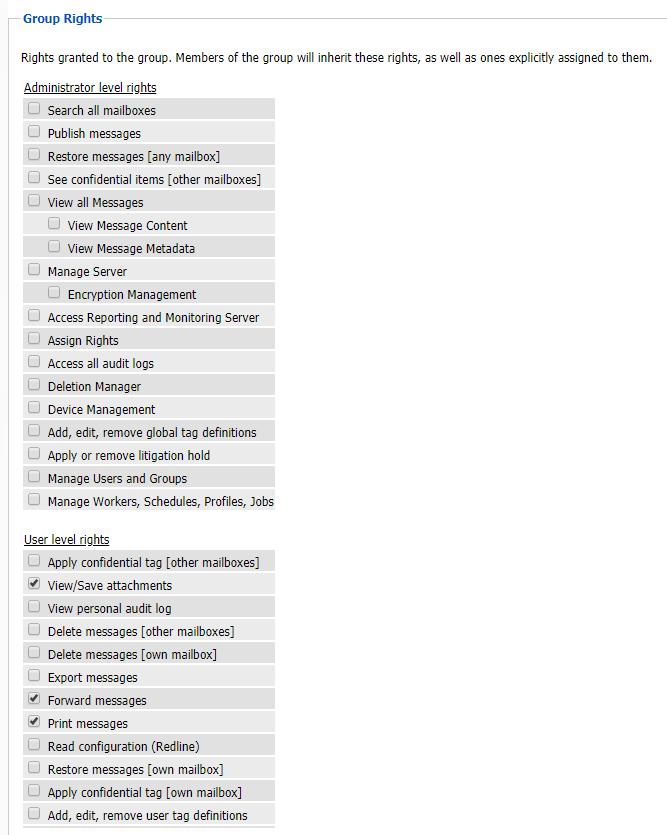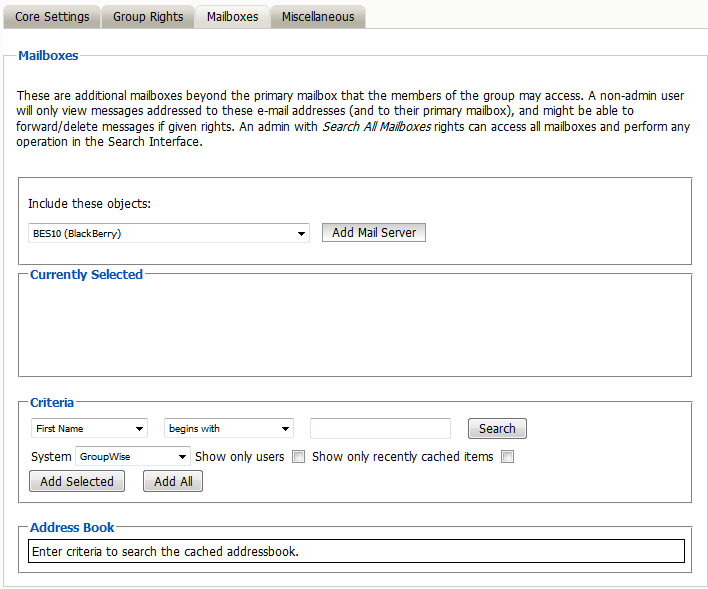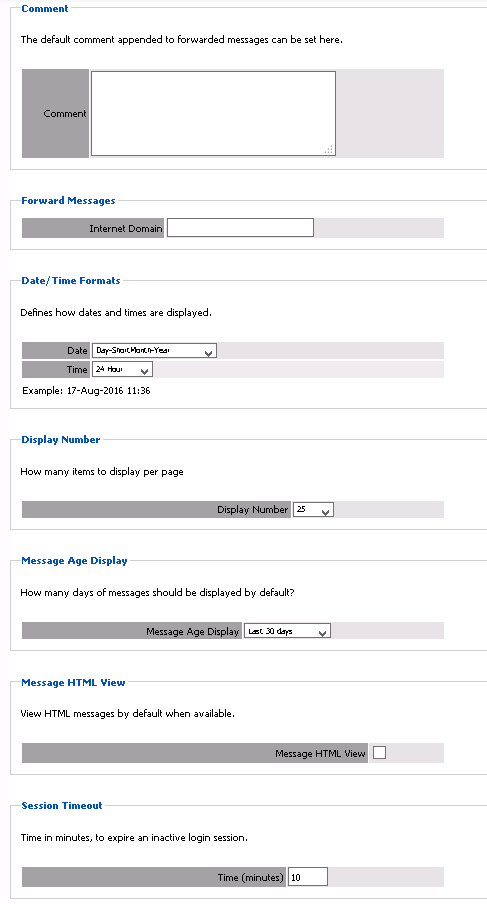10.2 Groups
Once you have created users, you can group them and give them common rights. For instance, you can make a group called “Auditors” and this group will have rights to certain specific functions. If you then add users to this group, these users will get those specific rights in addition to the rights you have explicitly given them.
This is a great way to save time in managing the rights of a large number of users.

This is the main Groups administration screen. It’s laid out just like the Users screen and rights are assigned the same way, for the most part.
In the Groups screen, you will see all defined groups. The group default is created when you install Retain. Users are automatically assigned to this group. If you want users to be part of another group, you must first create that group and then add users to it.
You will notice the drop-down list that allows you to select a member. If it says “(no users)”, it means that all users are part of the currently selected group and that there are no more users available to add.
You may specify the default language used in the Search Interface for this group of users.
10.2.1 Creating a New Group
If you want to create a new group, simply
-
Click “Add Group”
-
Type the name in “Group”
-
Change the properties of the group in the tabs below
-
Click “Save Changes”
Group Rights
Group rights are the same as user rights User Rights, just applied to the entire group.

In this tab, you define all the rights that will be common to all members of the group. These rights are ADDITIVE and will be in ADDITION to the rights you have explicitly given to the individual user.
For this reason, if you want to manage users as a group, you would typically not assign any individual rights. Rather, you would assign rights to their group. These rights have all the same meanings and functions as the user rights.
To log into and manage or monitor Workers, a User or Group must have the manage workers, Schedules, Profiles, Jobs right. To set or work with the Deletion Manager, the user must likewise have the Deletion Manager right, or they will not be able to modify those settings. There are, however, certain rights which implicitly grant other rights. For example, granting a Group the Restore Messages [Any Mailbox] right automatically grants the Restore Messages [Own Mailbox] right.
10.2.2 TIPS
Typically, you will not want to grant GroupWise Reporting and Monitoring rights to a group, but in a situation where you have more than one GroupWise Reporting and Monitoring control center and you want to see which one is monitoring, group-level GroupWise Reporting and Monitoring rights would be appropriate.
Typically, you will want to make the default group’s rights rather restrictive, granting very limited access by default. If you wanted a user to have more rights, you would simply assign them to another group or you could assign additional explicit rights.
By using groups, you can have groups of individuals with rights to totally different sets of archives. Other than their own mailboxes, users only get rights to the mailboxes that you grant to them.
Mailboxes

-
This screen works exactly like the user’s access to mailboxes. Please see the user’s mailbox section for details on how to select which mailbox or mailboxes to assign to the group.
-
You use the address book selector to choose which mailbox or mailboxes to give the group access to.
-
By default, groups have access to NO mailboxes; users may only access their own mailboxes. If the user exists only in Retain (no GroupWise account) and their group has access to no mailboxes, then they will have access to no mailbox either.
-
Only give group access to mailboxes when you want all members of the group to be able to access a particular mailbox. Some examples could include a general sales account or accounts being audited by a group of auditors, a workgroup needing to access each other’s archives, and so on.
10.2.3 Groups – Miscellaneous

This is exactly like the users’ miscellaneous configuration screen. It applies to all users in the group and users’ explicit settings will override the group settings.
These settings govern the way the search interface works for the selected group. See more information about these settings in the users’ miscellaneous section.